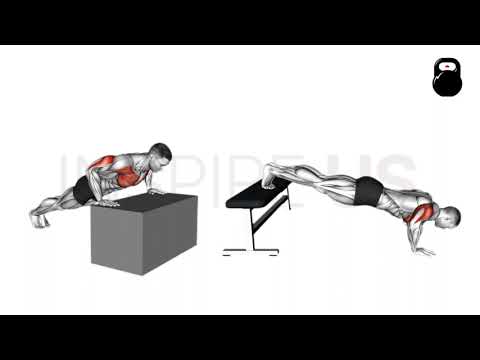Incline vs Decline Push-ups: Differences Explained
Even for relatively straightforward bodyweight exercises, big changes in impact may be made by simply altering the position of the body.
Such a fact is all the more true for the standard push-up - of which is simple in its stance and angle of resistance, as it primarily features the exerciser’s torso being set parallel in angle to the floor.
However, things may be taken a step further by changing this angle, allowing for greater focus on certain muscle groups and greater training specificity overall.
To condense the many differences between decline and incline push-ups; it may be said that the incline push-up is more effective at targeting the lower chest for greater volume, whereas the decline push-up is better for targeting the deltoids and upper chest at a greater level of resistance.
What are Incline and Decline Push-Ups?
Both incline and decline variations of the body weight push-up are multi-joint compound exercises performed for the purposes of training the upper body - either as a part of an athletic training routine, as a supplementary compound movement for bodybuilders or as a means of conditioning the arms and chest.
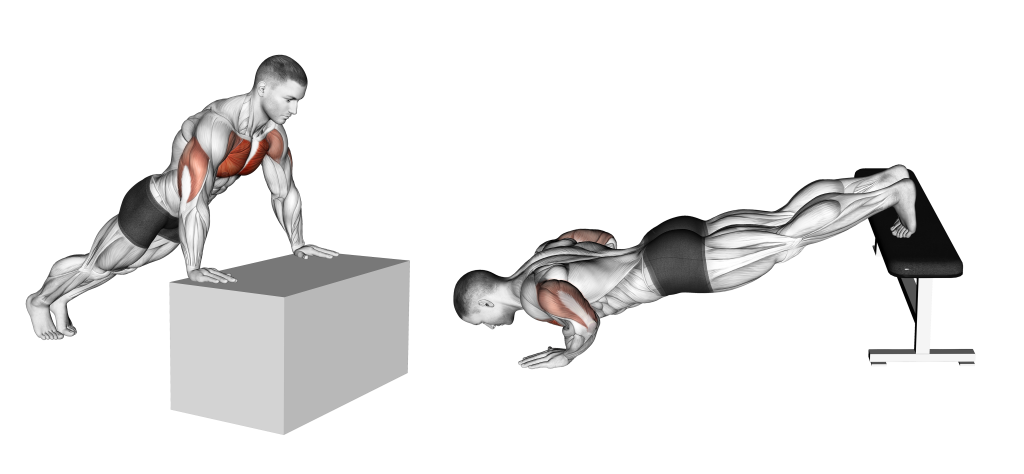
The Main Difference Between Incline and Decline Push-Ups
As is clued in by the name, incline push-ups set the torso at an inclined angle relative to the floor, with decline push-ups doing the opposite and setting the legs at an incline so as to angle the torso downwards.
Though a seemingly small change, altering the angle of the torso can change the range of motion, time under tension, muscular focus and even how much of the exerciser’s own weight is being lifted by their muscles during a push-up.
As such, it is important to first understand what the two push-up variations have in common before investigating which one is more appropriate to use.
Equipment Needed for Incline and Decline Push-Ups
Since both push-up variations are calisthenic exercises, they generally require no equipment apart from a wall, plyometric box, bench or stairway - all of which will depend on the extent of the angle involved.
For the greatest convenience, it is best to use an adjustable plyometric box that allows the exerciser to change the angle of their torso as needed.
The higher the feet during a decline push-up, the harder the exercise. For incline push-ups, setting the upper body lower will also increase the difficulty.
Both the incline and decline push-up train the same muscles - they differ only in the extent to which said muscles are worked.
Keeping this in mind, we can note that either exercise will recruit the pectorals, deltoids, triceps, serratus and core muscles at a high level of intensity.
How-to: Decline Push-Ups
To perform a decline push-up, the exerciser will set their feet atop an elevated object, maintaining a rigid core as they place their palms atop the ground, hands set wider than shoulder-width apart.
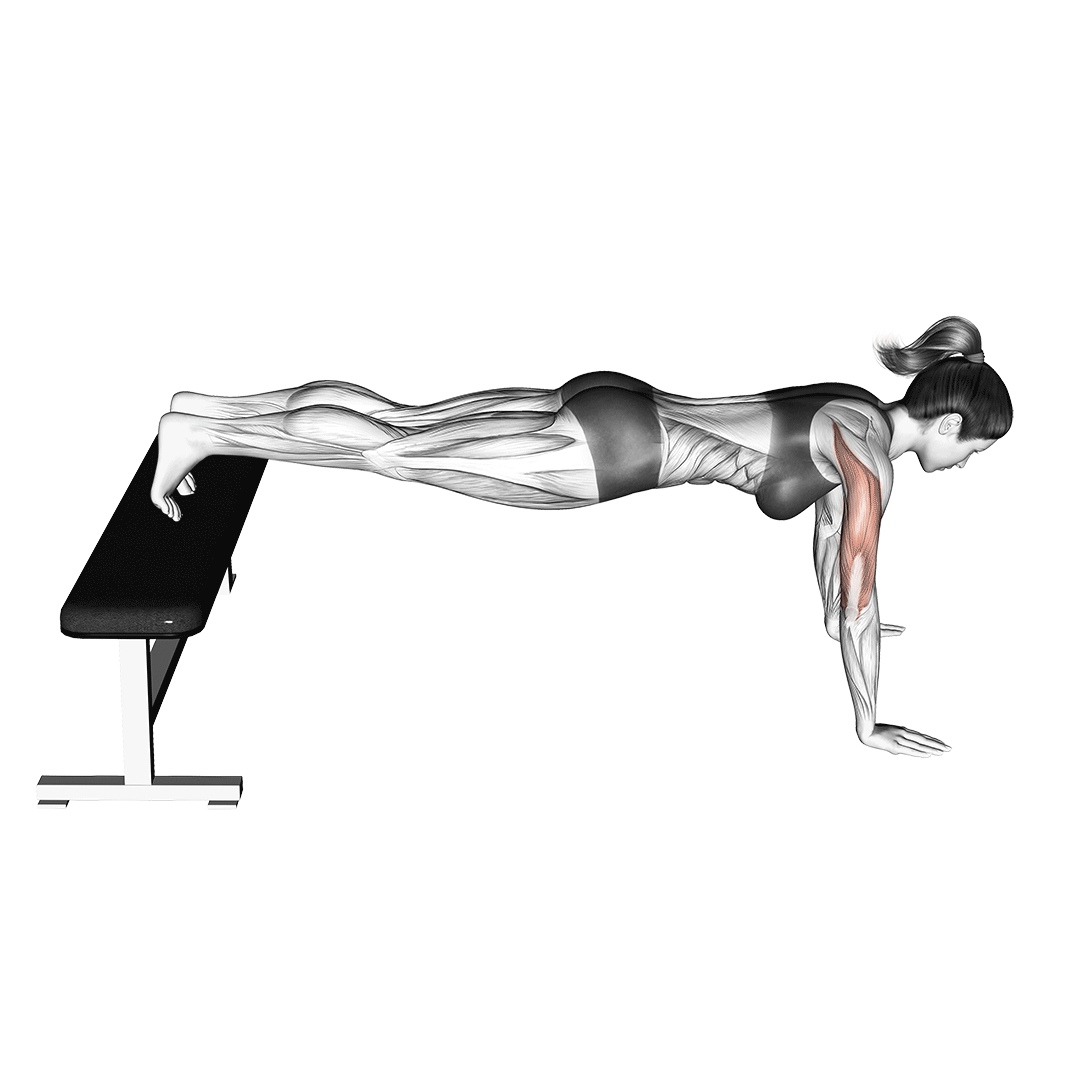
Bending at the elbows and flexing the pectoral muscles, they will lower themselves until the chest is within several inches of the floor, pausing for a moment before pushing through the palms and returning to the starting position.
Note that at higher levels of elevation, it is the head (rather than the chest) that will be the first to reach appropriate depth, and that this is entirely normal and still counts as a complete range of motion.
How-to: Incline Push-Ups
To perform an incline push-up, the exerciser will set their hands atop an elevated object, maintaining a tight core as they lean over the object with their arms fully extended and the feet set on the ground.
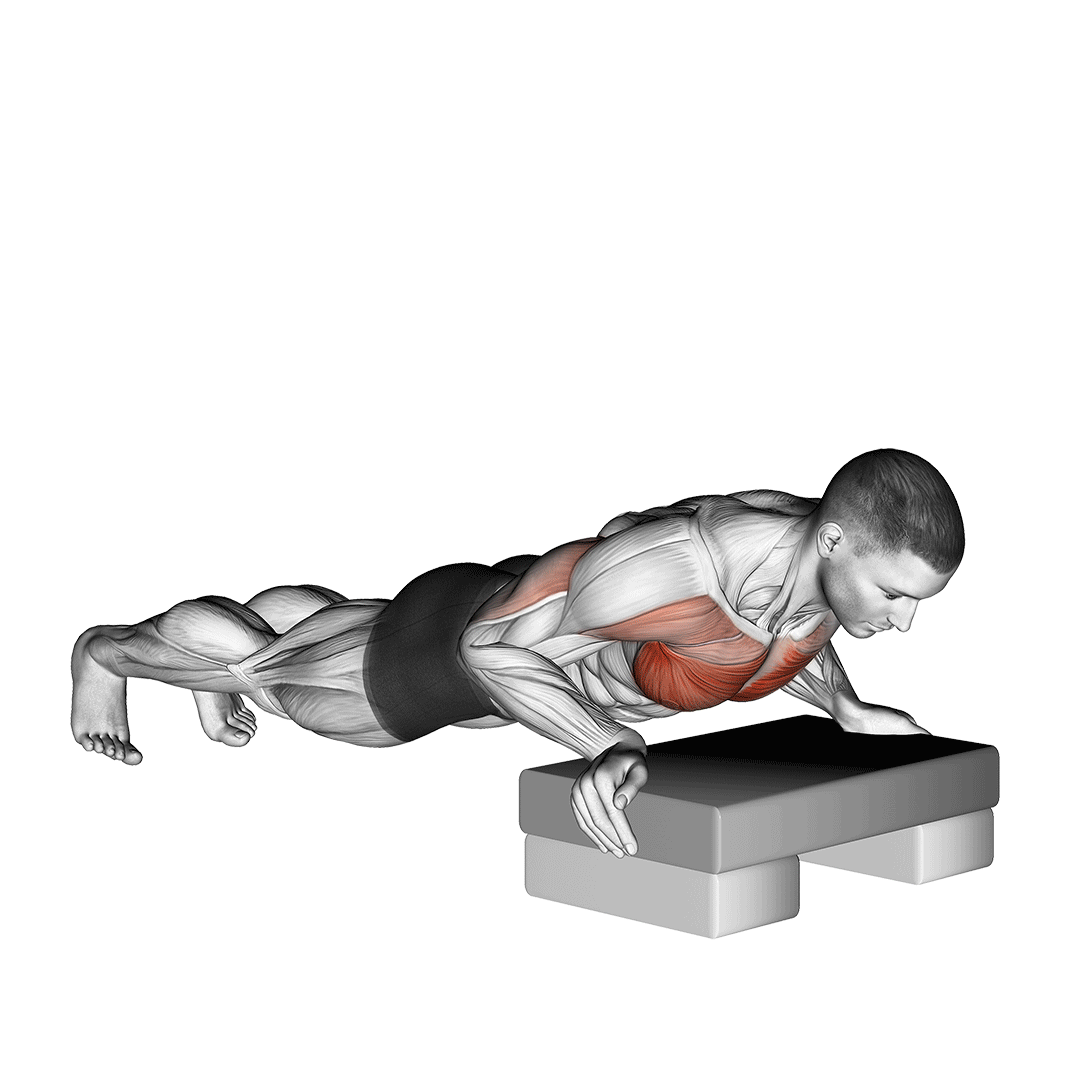
From this position, the exerciser will then bend at the elbows, lowering their chest until it is nearly touching the elevated object, before pushing through the palms and returning to the starting position.
Because of the elevated position of the torso, the range of motion of the incline push-up is noticeably shorter, and far less of the exerciser’s own body weight is moved by the muscles.
This translates to an easier exercise, and will require more volume to reach sufficient intensity.
Muscles Targeted by Incline Push-Ups and Decline Push-Ups
While both the incline and decline push-up train the same general muscle groups (the chest, arms and shoulders), the actual focus of each exercise shifts due to the angle of gravity relative to the entire body.
That being said, the stabilizer and secondary mover muscles remain much the same between the two exercises, and as such either one may be used interchangeably with the other for the purposes of general upper body training.
Incline Push-Up
Because the incline push-up features a shorter range of motion and the torso being set higher than the legs, it is the lower portion of the pectoral muscles that is targeted to the greatest extent.
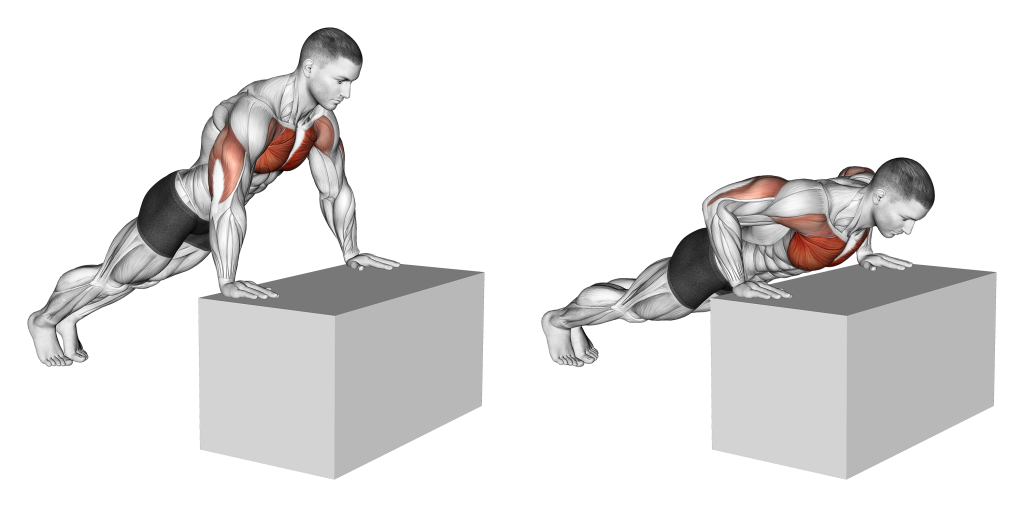
In a more technical sense, it is the sternocostal and abdominal “heads” of the pectoralis major muscle that are targeted the most by incline push-ups, though one may wish to note that the entire pectoralis major is recruited to great intensity nonetheless.
Decline Push-Up
Decline push-ups force the muscles to bear more of the body’s weight, and will often feature a slightly longer range of motion on account of the legs being elevated higher than the torso.

This causes the anterior deltoid to be worked greater than they would be in most other push-up variations, and will allow the upper or minor pectoral muscle to undergo a longer time under tension as well.
Complexity and Difficulty of Incline Push-Ups and Decline Push-Ups
In terms of form complexity and the actual amount of effort needed to complete either exercise, it can be said that the incline push-up is relatively easier than the standard push-up, and that the decline push-up is considerably more difficult.
While the main form cues are identical between both push-up variation, it can be said that the decline push-up is more technically complex, as it requires greater control over the elbow joint and involves a longer time under tension.
As such, for novice exercisers, the incline push-up is likely the more accessible choice.
Which Push-Up Variation is Harder?
Range of motion, complexity and time under tension notwithstanding, the amount of the exerciser’s own weight that is lifted will differ between the two exercises.
Because the legs are lower than the torso and thereby bearing more weight, the incline push-up is considerably easier to perform per repetition, and is even used as a progression step to conventional push-ups for novice exercisers.
Conversely, the decline push-up places far more of the exerciser’s weight on their shoulders and chest, thereby making each repetition harder but also resulting in greater efficiency per repetition - a very important factor for more advanced calisthenic athletes.
Incline Push-Ups and Decline Push-Ups for Mass
For bodybuilders or at-home exercisers seeking greater muscle mass, the question becomes less of which exercise builds more muscle, but which is more appropriate for their specific usage.
In the case of novice exercisers or those who wish to build out the lower section of their pectoral muscles, the incline push-up may be a better choice - though they should keep in mind that it is considerably lower in intensity and resistance, and as such may not be as suitable for building mass as other exercises.
However, the same cannot be said for the decline push-up, of which will enhance the already effective mass-building benefits of conventional push-ups - leading to greater deltoid mass and upper pectoral muscle size.
In Short
In short, unless the exerciser is relatively new to training and is unable to perform standard push-ups in an effective manner, it is better to pick the decline push-up over the incline push-up.
Incline Push-Ups or Decline Push-Ups for Strength and Athleticism
The concept of building strength and athletic ability is somewhat more nuanced than that of gross muscular hypertrophy, as it is not just resistance and volume that is important.
Other factors like tempo, total training volume and even the relative angle of resistance can affect how an exercise conditions the body to real-world athletic activities.
As such, when considering incline and decline push-ups, we must first identify how they condition the muscles of the upper body.
For Strength, the Decline Push-Up
In exercise science, the concept of specificity refers to how performing a specific task will improve the performer’s capacity to do said task in the future.
This is all the more applicable when training for strength, as there are few ways to improve push-ups (and similar resistance exercises) better than performing push-ups themselves.
The decline push-up particularly excels for this purpose, as it will condition the body to performing the movement under a greater amount of resistance than would be the case with incline or conventional push-ups.
Over time, this will lead to neurological and muscular strength adaptations, of which will transfer to other activities involving elbow extension or pectoral muscle recruitment.
For Athleticism, Both
Though decline push-ups are excellent for specificity of training stimulus, they are not as effective at developing upper body athleticism for much the same reason that they are useful for strength development; decline push-ups are difficult to perform, especially in great volume.
If athleticism solely required strength, then this would not be the case, but as it stands, other physical aspects of training like explosiveness, muscular endurance and general athletic carryover must also be considered.
In order to cover all bases, the best route to take would be to perform both decline push-ups and incline push-ups, with decline push-ups as the primary compound movement and source of general training stimulus, and incline push-ups as an accessory compound exercise to help build technical skill and bulk up the workout’s total volume.
Frequently Asked Questions (FAQ)
Are Incline Push-Ups Harder or Decline?
Incline push-ups are considerably easier than decline push-ups, as incline push-ups will leverage less of the body’s weight and generally feature a shorter range of motion.
In fact, incline push-ups are considered to be easier than standard push-ups as well, making them perfectly suited to newer exercisers who cannot perform regular push-ups yet.
Which Type of Push-Up is Best for the Chest?
To maximize chest activation during push-ups, setting the hands further apart is your best bet.
Exercises like the wide-grip push-up and archer push-up will both reduce the involvement of the triceps and deltoids, forcing the pectoral muscles to bear more of the resistance.
How Many Incline Push-Ups Equal One Push-Up?
Incline push-ups are generally easier than conventional push-ups, and as such it can be said that 2-3 incline push-ups will “equal” a single conventional push-up.
This, of course, will depend on many factors and is only a loose range.
In Conclusion, Which Push-Up Variation is Better?
To collate all information in this article, we can come to the conclusion that it is the decline push-up that is better in most aspects - though the incline push-up does serve its purpose as a progression to regular push-ups, or as a way of getting more chest and triceps volume into a training session.
Keep in mind that proper exercise selection is only a small portion of the puzzle, and that other factors like form adherence, training programming and recovery must also be optimized in order to reap all the benefits that either push-up variation can provide.
References
1. Kowalski KL, Connelly DM, Jakobi JM, Sadi J. Shoulder electromyography activity during push-up variations: a scoping review. Shoulder & Elbow. 2022;14(3):325-339. doi:10.1177/17585732211019373
2. Glass SC, Armstrong T. Electromyographical activity of the pectoralis muscle during incline and decline bench presses. J Strength Cond Res. 1997;11(3):163–167.
3. Ebben, William P; Wurm, Bradley; VanderZanden, Tyler L; Spadavecchia, Mark L; Durocher, John J; Bickham, Curtis T; Petushek, Erich J. Kinetic Analysis of Several Variations of Push-Ups. Journal of Strength and Conditioning Research 25(10):p 2891-2894, October 2011. | DOI: 10.1519/JSC.0b013e31820c8587

